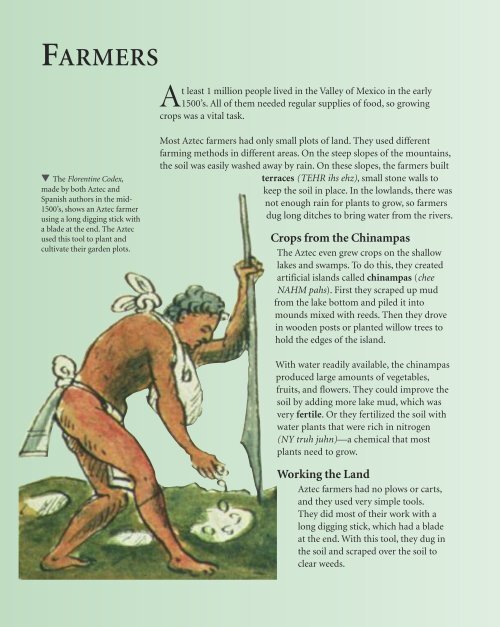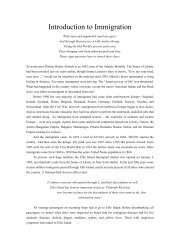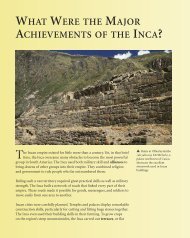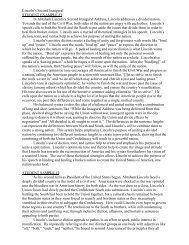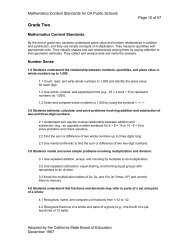Create successful ePaper yourself
Turn your PDF publications into a flip-book with our unique Google optimized e-Paper software.
FARMERS<br />
At least 1 million people lived in the Valley of Mexico in the early<br />
1500’s. All of them needed regular supplies of food, so growing<br />
crops was a vital task.<br />
▼ The Florentine Codex,<br />
made by both <strong>Aztec</strong> and<br />
Spanish authors in the mid-<br />
1500’s, shows an <strong>Aztec</strong> farmer<br />
using a long digging stick with<br />
a blade at the end. The <strong>Aztec</strong><br />
used this tool to plant and<br />
cultivate their garden plots.<br />
Most <strong>Aztec</strong> farmers had only small plots of land. They used different<br />
farming methods in different areas. On the steep slopes of the mountains,<br />
the soil was easily washed away by rain. On these slopes, the farmers built<br />
terraces (TEHR ihs ehz), small stone walls to<br />
keep the soil in place. In the lowlands, there was<br />
not enough rain for plants to grow, so farmers<br />
dug long ditches to bring water from the rivers.<br />
Crops from the Chinampas<br />
The <strong>Aztec</strong> even grew crops on the shallow<br />
lakes and swamps. To do this, they created<br />
artificial islands called chinampas (chee<br />
NAHM pahs). First they scraped up mud<br />
from the lake bottom and piled it into<br />
mounds mixed with reeds. Then they drove<br />
in wooden posts or planted willow trees to<br />
hold the edges of the island.<br />
With water readily available, the chinampas<br />
produced large amounts of vegetables,<br />
fruits, and flowers. They could improve the<br />
soil by adding more lake mud, which was<br />
very fertile. Or they fertilized the soil with<br />
water plants that were rich in nitrogen<br />
(NY truh juhn)—a chemical that most<br />
plants need to grow.<br />
Working the Land<br />
<strong>Aztec</strong> farmers had no plows or carts,<br />
and they used very simple tools.<br />
They did most of their work with a<br />
long digging stick, which had a blade<br />
at the end. With this tool, they dug in<br />
the soil and scraped over the soil to<br />
clear weeds.
F A R M E R S 21<br />
▲ The Codex Fejervary-Mayer, painted on deerskin before the 1521<br />
conquest, illustrates the effects of weather on the <strong>Aztec</strong>’s corn crop over<br />
a two-year period. In the first year (top right), a goddess pours rain<br />
down over a healthy plant. In the second year (top left), the plant<br />
withers during a drought. The <strong>Aztec</strong> believed that a single god, Tlaloc<br />
(TLAH lohk), was responsible for both plentiful rain and drought.<br />
Beans, corn, squash, sweet potatoes, and tomatoes were the<br />
main crops grown by the <strong>Aztec</strong>. On the drier lowlands,<br />
farmers grew cotton, cactus, and maguey (MAG way or mah<br />
GAY), a term for certain types of agave (uh GAH vee) plants.<br />
Maguey was a very useful plant. The <strong>Aztec</strong> made cloth from<br />
the leaves, sewing needles from the sharp spines, and<br />
medicines and an alcoholic drink from the juice.<br />
WHERE WERE THE ANIMALS?<br />
During the time that the <strong>Aztec</strong><br />
ruled, there were no horses,<br />
cattle, hogs, or sheep in the<br />
Western Hemisphere. They<br />
arrived with the Europeans.<br />
Therefore, the <strong>Aztec</strong> had no<br />
milk or wool and no draft<br />
animals, that is, strong animals<br />
used to pull plows or carry<br />
heavy loads. Livestock on<br />
<strong>Aztec</strong> farms was primarily<br />
turkeys, ducks, and rabbits.


